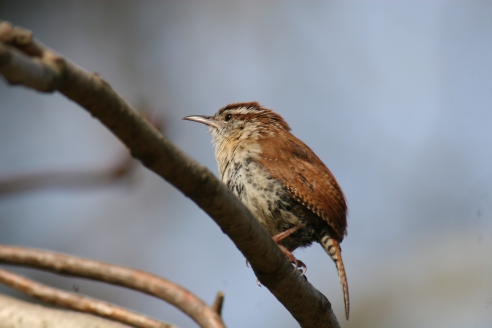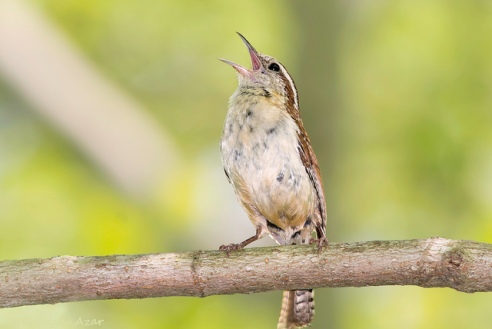Why You Should Be Bird Literate

Carolina wren (Courtesy of Kelly Colgan Azar)
Welcome to installment number one in the Get to Know Your Neighbors series, inspired by a couple of brilliant friends who can’t tell a merlin from a mockingbird. I can think of a few compelling reasons why they–why everyone–should be bird literate:
- It’s easy. The average American encounters a small number of easily-identifiable species in their daily life. Over a recent weekend in my family’s backyard in South Carolina, I counted ten common species, none too confusing between the vibrant colors and ranges in size. City dwellers need learn even fewer names to master the local avian fauna.
- It’s deeply rewarding. Naming and classifying are primeval human impulses. Once you learn to identify a few birds, you’ll take pleasure in recognizing them all around you. It’s simple, illuminating knowledge that lends meaning to your sense of place.
- You can use your powers for good. The birding community has long been among the pioneers of citizen science projects, leveraging people’s love of birds to collect critical data about changing migration patterns, diseases like West Nile virus, and biodiversity.
- Birds are hilarious. Watch an overexcited house sparrow in the throes of mating season. He will puff-ruffle his feathers and sing a godawful song (Forever Alone) and, if all else fails, grab a sprig of greenery and sing with his mouth full. The ladies are not impressed.
GET TO KNOW The Carolina Wren, South Carolina’s State Bird
I’m starting with the Carolina wren because (1) it’s a state bird done right (watch and learn, North Carolina) and (2) the bird’s got so much sass. You’d never guess the loudest and most melodic song in the neighborhood comes from a fat little bird the size of a golfball. With its pretty call and diminutive stature, you might mistake the Carolina wren for a dainty seed-eater, but no. The species actually prefers devouring other animals. Spiders, ants, caterpillars, and other insects comprise the majority of a wren’s diet, but the songbird will even dash small lizards and frogs to pieces, or swallow them whole.
Two nesting pairs occupy my family’s backyard, and I can often hear more male voices crooning nearby in the woods. They hop and spar around the bird feeder, darting from bush to dirt to bark as if the verb flit was invented just for them, their shorts tails cocked skyward. Carolina wrens show less leeriness than birds three times their size, and seem to take a perverse pleasure in spilling twenty sunflower seeds from the bird feeder for every one they eat. I recently watched a pair taking a dirt bath side-by-side, looking positively gleeful as they riffled their feathers and shimmied in the dusty soil.
Carolina wrens act aggressively toward any birds in their territory, but scientists have found they reciprocate less hostility with regular neighbors.1 This makes sense, since a twenty gram creature can’t afford to expend energy defending its home against birds it sees every day. Neighboring wrens like those in my backyard will squabble and chase each other around, but generally consent to share resources. Not so for strangers wandering in–ecologists call this the “dear enemy” phenomenon, and they’ve observed it in many species.
I wanted to see the science myself, so I played recordings of an alien Carolina wren at full volume from my screened-in back porch (which, full disclaimer, I did before reading this so I cannot condone my actions). The effect was immediate. One of the males came shooting out of the fig tree and flew at the porch. He hopped around the eaves of the house, tilting his head as if to discern the source of the stranger’s song. I had never seen the wrens come close to the porch. He repeated the action each of the three times I played back the recording, after which I felt guilty for agitating him. Sometimes ecologists, it turns out, are just big bird bullies.
Unlike many of its fellow avians, the Carolina wren stands to gain from the changing climate.2 Models project that as winters grow milder at the northern boundary of the bird’s distribution, the species’ range could expand 25-50% by the end of the century. That’s good news for folks in New England and the Great Lakes, who will start to see more of this feisty bird as it settles far beyond its namesake.
-
Hyman, Jeremy. 2002. “Conditional strategies in territorial defense: do Carolina wrens play tit-for-tat?” Behavioral Ecology 13(5): 664-669 doi:10.1093/beheco/13.5.664.
-
Matthews, Stephen; O’Connor, Raymond; Iverson, Louis R.; Prasad, Anantha M. 2004. Atlas of climate change effects in 150 bird species of the Eastern United States. Gen. Tech. Rep. NE-318. Newtown Square, PA: U.S. Department of Agriculture, Forest Service, Northeastern Research Station. http://www.fs.fed.us/ne/newtown_square/publications/technical_reports/pdfs/2004/gtr318/download/GTR_NE318_pg284_340.pdf




5 Responses to “Why You Should Be Bird Literate”
WAIT WHAT IS A MERLIN.
It’s a wizard disguised as a falcon.
It’s a falcon disguised as a wizard.
[…] This is an installment of the Get to Know Your Backyard Birds series. Read part one here. […]
[…] installments one and two of the Get to Know Your Backyard […]